MISTRESS OF THE MACABRE: C.J. TUDOR ON REIMAGINING
THE VAMPIRE MYTH IN THE GATHERING
The Big Thrill Interviews Award-Winning Author C.J. Tudor
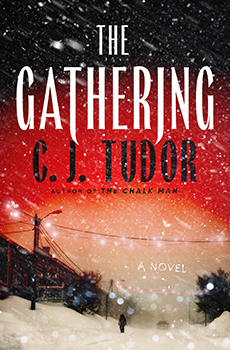 C.J. Tudor went from a virtual unknown to “Britain’s female Stephen King” seemingly overnight. But before that fortuitous occurrence, she was many things: dog walker, reporter in training, voiceover artist, radio scriptwriter, television personality, and copywriter. Then came The Chalk Man—a nostalgic, nerve-jangling tale of childhood best friends bonded for life by a terrifying discovery that would shape the adults they became. An instant bestseller, the book won Barry, Strand Magazine, and ITW Thriller Awards and sold to more than 40 countries. All of a sudden, the world was watching…and writing would never quite be the same.
C.J. Tudor went from a virtual unknown to “Britain’s female Stephen King” seemingly overnight. But before that fortuitous occurrence, she was many things: dog walker, reporter in training, voiceover artist, radio scriptwriter, television personality, and copywriter. Then came The Chalk Man—a nostalgic, nerve-jangling tale of childhood best friends bonded for life by a terrifying discovery that would shape the adults they became. An instant bestseller, the book won Barry, Strand Magazine, and ITW Thriller Awards and sold to more than 40 countries. All of a sudden, the world was watching…and writing would never quite be the same.
Still, Tudor found a way to stay true to her unique vision, even as the weight of expectations descended. Four novels and a short story collection—featuring everything from human killers and ghosts to zombies and deadly viruses—followed, cementing her status as a mistress of the macabre. This April, she returns with THE GATHERING—a modern take on the vampire myth (vampires being the “sexy” monster) that eschews long-held pop culture stereotypes for something decidedly non-“twinkly”…and mortal.
Detective Barbara Atkins is summoned to the rural Alaskan town of Deadhart, where the body of a young man has been found, his throat ripped out and his blood drained. This discovery harkens back to a similar crime from 25 years ago, allegedly perpetrated by a member of the Colony, an outcast group of vampires who lived on the fringes of the community. Forced out under the threat of a Cull by the humans, they’ve only recently returned to the area. Can Barbara quell the bloodlust, or will they once again find themselves on the cusp of war for an atrocity they may or may not have committed?
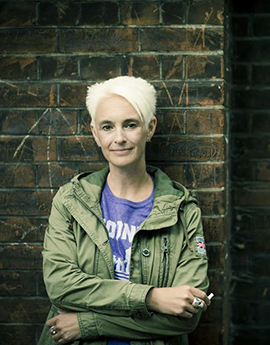
© Bill Waters
Now, C.J. Tudor talks to The Big Thrill about her (ahem) high-stakes novel of monsters and men—and the thin line that separates them.
THE GATHERING is a fresh take on a familiar “monster”: vampires. What was your approach to melding the stereotype(s) with a more original vision, and how has modernity helped to liberate these beings from their shackles?
I’ve always wanted to write a vampire novel, and I’d flirted with a few ideas. But vampires have been done to death (no pun intended), so I wanted to bring something new to the genre.
In THE GATHERING, vampires (or vampyrs as I call them in the book) have always existed—but largely pose no threat to humans, living on animal blood. However, due to fear and superstition, they have been hunted almost to extinction. Only a few colonies remain in remote areas, and those colonies are protected by law. Vampires cannot be hunted or killed—unless they pose a threat to human life. In which case, an order can be made to cull the entire colony.
Your protagonist, Det. Barbara Atkins is both an outsider entering an insular community and an ordinary person tasked with extraordinary responsibilities (like preventing a culling!). What of her personality and past allows her to navigate the opposition she’s met with peaceably, and how does her devotion to truth begin to influence those around her?
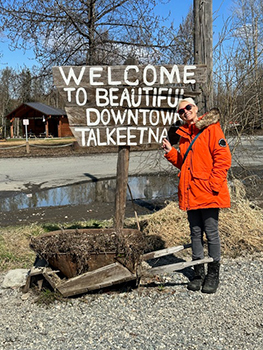
I loved writing Barbara. She’s a character people underestimate. She’s in her 50s, plain, a little frumpy. But she’s sharp and good at reading people. She has a way with her that gets people to talk to her and gets under the skin of things.
And she’s familiar with towns like Deadhart—and the colonies—having grown up in a ‘colony town’ as a child. That gives her a unique perspective.
Barbara forms an unlikely partnership with former (disgraced) Sheriff Jenson Tucker. What are the dynamics of their working relationship, and how is his presence both a help and hindrance to her investigation?
Well, Tucker knows the history of Deadhart and the Colony well. He investigated the last murder in Deadhart 25 years ago when a vampire supposedly killed another young boy. But he’s also an outcast. The townspeople blame him for almost letting the killer get away. And he’s a man with his own secrets.
The book is set in a fictional Alaskan town (Deadhart) that takes its inspiration from real places you visited. Tell us about this choice of backdrop and how its atmosphere serves the story.
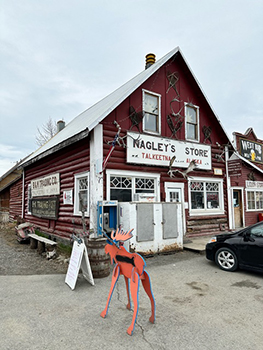
Oh, the town is everything. I wanted to set the book in Alaska because it just seemed the perfect location: the cold, the dark, the remoteness. And obviously, it has been used before as a setting for a vampire story in the film 30 Days of Night. Small towns are wonderfully insular. They have their own ways, rules and traditions—and that was especially important in this novel.
I did a lot of research online first, and I found a town that pretty much fit my vision of Deadhart—a place called Talkeetna. It had to be remote but also big enough to have a proper community—shops, bars, businesses, and also a decent number of suspects! But I believe if you’re going to write about somewhere, you need to visit it; you need to get your boots on the ground! So, in 2022, my husband and I travelled to Alaska and stopped in Talkeetna for a few days.
We hung out, talked to people, took lots of photographs, just soaked the place up essentially. It really helped to flesh out my fictional town of Deadhart. I always think it’s the small details that add authenticity—where people live, what they wear, what they eat. I mean, I’d never heard of reindeer sausage before!
Though the book is fictional, it can be interpreted as an allegory about the divisiveness that fear and the unknown can create among people and within communities. What real-life societal issues were on your mind as you wrote this, and was their influence on the narrative a deliberate choice or a more subconscious development?
I always believe, story first, and anything else kind of grows organically from that. So, yes, as I started to write, I realised that the relationship between the people of Deadhart and the vampires was very relevant to a lot of things going on right now. The divisions between the ‘woke liberals’ who want to protect the vampire colonies and those who believe they are a menace and should be exterminated. But I wanted to present both sides. The attitudes of the townspeople towards the vampire colony—their tradition of hunting vampires and keeping skulls and teeth as souvenirs—seem barbaric. But they’ve lived their whole lives with the constant threat of the vampires living close by. As Barbara muses, “It’s easy to be liberal when the wolf isn’t at your door.”

In many ways, the vampires are a metaphor for how we treat those we see as ‘other’—whether that’s because of race, sexuality or religion. It’s about how fear and taking sides can blind us to the truth.
What are some of your favorite renderings of vampires within the pop culture lexicon, whether in books, film, or other media? Why do you think they’ve achieved such longevity?
Vampires are the ‘sexy’ monster, aren’t they? The whole biting of the neck, immortality, staying forever young. There’s something undeniably seductive about the vampire myth.
Straight away, I should say my vampires are not like that. For starters, they’re not supernatural. They live for hundreds of years, but they’re not immortal; they can’t turn into bats or smoke. They can be seen in mirrors, and garlic and crosses won’t do you much good. They are feral, brutal, and their long existence is more of a curse than anything.
My favourite vampire renderings are The Lost Boys, 30 Days of Night, Near Dark, and Let the Right One In. Oooh, and Salem’s Lot. Do not give me twinkly vampires. None of that rubbish!
You are revered among your readers and have earned many comparisons to Stephen King (including mine!). Is it difficult to balance your own creative ambitions with others’ expectations? Assuming so, how have you attempted to reconcile this as your popularity and the demands on your time have grown?
One of my dreams when I was working as a dog walker for £10 an hour was to one day be compared to Stephen King. It’s probably the biggest compliment you could give to a writer (and especially me, a constant lifelong reader).
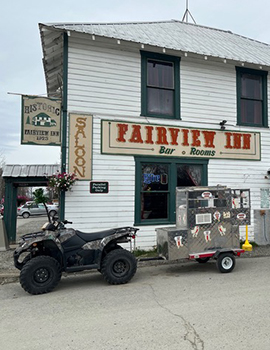
My first novel, The Chalk Man, was a huge homage to Mr. King and all the books and films I loved as a teenager in the 80s. But I like to think, with six books under my belt now, I’ve proved I have my own voice and my own unique stories to tell.
I try not to dwell on other people’s expectations as I think it hampers you. I write best when I write just for me. That’s all you can ever do. Write what you love and accept that everything else is out of your control.
Leave us with a teaser: What comes next?
Well, my next novel is called The Cutters. It’s mostly set in a girl’s boarding school (Cutters Hill) in 2005. Four pupils find something strange underground in the woods. When they emerge, they find everyone in the school has disappeared.
Or have they? As far as everyone else is concerned—including DI Fred Dunn, who is called to investigate the case—it’s the four girls who have disappeared without a trace.
Obviously, there’s time travel involved, and a serial killer in the present day with a unique modus operandi—they pick a victim and travel back in time to kill their mother, ensuring they never exist.
Timey-wimey stuff, complicated female relationships, lots of twists and turns. I think of it as Heathers meets The Shining Girls.
The Big Thrill Interviews Award-Winning Author C.J. Tudor
- Trial by Ambush - December 16, 2024
- Africa Scene:
Iris Mwanza
by Michael Sears - December 16, 2024 - Elle Marr - August 1, 2024
